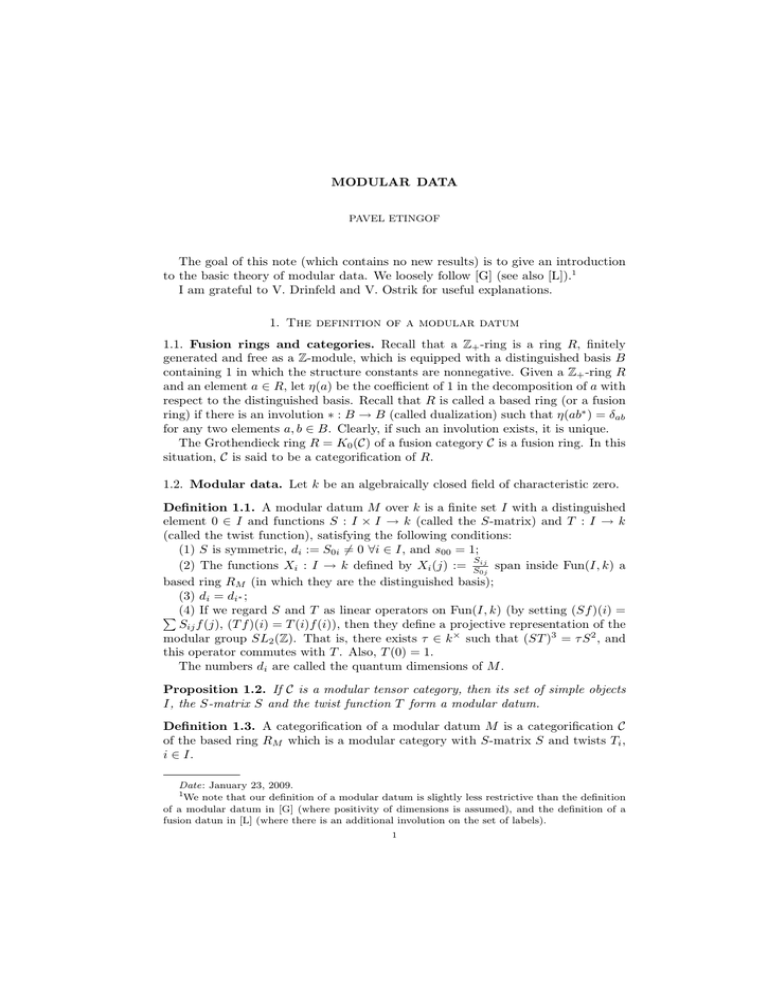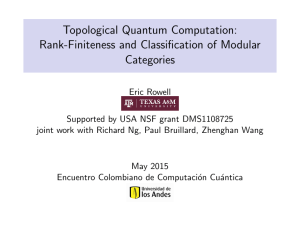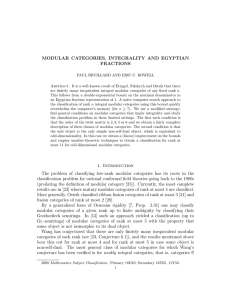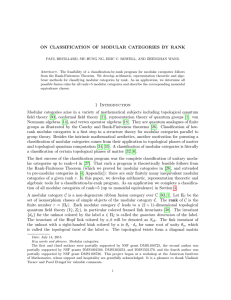MODULAR DATA
advertisement

MODULAR DATA PAVEL ETINGOF The goal of this note (which contains no new results) is to give an introduction to the basic theory of modular data. We loosely follow [G] (see also [L]).1 I am grateful to V. Drinfeld and V. Ostrik for useful explanations. 1. The definition of a modular datum 1.1. Fusion rings and categories. Recall that a Z+ -ring is a ring R, finitely generated and free as a Z-module, which is equipped with a distinguished basis B containing 1 in which the structure constants are nonnegative. Given a Z+ -ring R and an element a ∈ R, let η(a) be the coefficient of 1 in the decomposition of a with respect to the distinguished basis. Recall that R is called a based ring (or a fusion ring) if there is an involution ∗ : B → B (called dualization) such that η(ab∗ ) = δab for any two elements a, b ∈ B. Clearly, if such an involution exists, it is unique. The Grothendieck ring R = K0 (C) of a fusion category C is a fusion ring. In this situation, C is said to be a categorification of R. 1.2. Modular data. Let k be an algebraically closed field of characteristic zero. Definition 1.1. A modular datum M over k is a finite set I with a distinguished element 0 ∈ I and functions S : I × I → k (called the S-matrix) and T : I → k (called the twist function), satisfying the following conditions: (1) S is symmetric, di := S0i 6= 0 ∀i ∈ I, and s00 = 1; Sij (2) The functions Xi : I → k defined by Xi (j) := S0j span inside Fun(I, k) a based ring RM (in which they are the distinguished basis); (3) di = di∗ ; (4) If we regard S and T as linear operators on Fun(I, k) (by setting (Sf )(i) = P Sij f (j), (T f )(i) = T (i)f (i)), then they define a projective representation of the modular group SL2 (Z). That is, there exists τ ∈ k × such that (ST )3 = τ S 2 , and this operator commutes with T . Also, T (0) = 1. The numbers di are called the quantum dimensions of M . Proposition 1.2. If C is a modular tensor category, then its set of simple objects I, the S-matrix S and the twist function T form a modular datum. Definition 1.3. A categorification of a modular datum M is a categorification C of the based ring RM which is a modular category with S-matrix S and twists Ti , i ∈ I. Date: January 23, 2009. 1 We note that our definition of a modular datum is slightly less restrictive than the definition of a modular datum in [G] (where positivity of dimensions is assumed), and the definition of a fusion datun in [L] (where there is an additional involution on the set of labels). 1 2 PAVEL ETINGOF P Theorem 1.4. (i) Let D = i d2i . Then D 6= 0, and one has S 2 = DC, where Cij = δij ∗ (ii) The numbers Sij /dj (in particular, di ) and D/d2i are algebraic integers. √ (iii) di are totally real and D − 1 is totally positive. The matrix S/ D (well defined up to sign) is totally unitary. P Proof. (i) By (2), S is invertible. So we have δj = s0j i (S −1 )ji Xi . Thus for j 6= m we have X (S −1 )ji (S −1 )mr Xi Xr = 0. i,r In particular, applying η to this equality and using the symmetry of S, we get X (S −1 )ji (Si−1 ∗ m ) = 0. i −1 −1 Thus, S CS is a diagonal matrix, hence so is SCS. m Now, let Nij be the structure constants of RM . Then by definition X m Sir Sjr = Nij Smr S0r . So since Srj = Sjr and S0r = Sr0 = Sr∗ 0 , we get X m Sir Srj = Nij Smr Sr∗ 0 . Summing this over r, and using that SCS is diagonal, we get (S 2 )ij = δij ∗ D. (ii) By definition, Sij /dj is an eigenvalue of the integer matrix Ni of multiplication by Xi in RM , thus it is an algebraic integer. Now, X sij sji∗ D = , d2i di d∗i j so it is also an algebraic integer. (iii) 2di = di + di∗ is an eigenvalue of the matrix Ni + Ni∗ , which is a symmetric integer matrix. So di is totally real. Next, (Sij + Si∗ j )/dj is also an eigenvalue of Ni + Ni∗ , so it is also totally real and hence Si∗ j is totally complex conjugate to Sij . This together with (i) implies that under any complex embedding of Q(Sij ), SS † = D, where † is the Hermitian adjoint to S, as desired. 2. The Anderson-Moore-Vafa property Let C be a modular tensor category with simple objects Xi . Consider the space r Eijm = Hom(Xr , Xi ⊗ Xj ⊗ Xm ). Using the braiding this space is identified with r Ejim . The hexagon relation for the braiding implies that 2 2 2 r r r det(βij,m |Eijm ) = det(βjm |Eijm ) det(βim |Ejim ). Recall that β 2 acts on Hom(Xs , Xp ⊗ Xq ) by the scalar Tp Tq /Ts . Therefore, the last identity can be rewritten in the form Y Y p p p r r r Y (Tp Tm /Tr )Nij Npm = (Ti Tm /Tp )Nim Njp (Tj Tm /Tp )Njm Nip . p This implies the following result. p p MODULAR DATA 3 Theorem 2.1. (Anderson-Moore-Vafa) For a categorifiable modular datum, one has p p r r r Y N p Npm r Njp Nip +Nim +Njm , (Ti Tj Tm Tr )Nijm = Tp ij p where r Nijm := p r p Nij Npm . P Corollary 2.2. ([E]) For a√categorifiable modular datum, T N = 1 for some N dividing D5/2 . Therefore, τ / D is a root of unity of order dividing 4D5/2 |I|. Proof. The Anderson-Moore-Vafa equation can be written as the following equation in Z ⊗Z k × : X p p p r r r r Nijm ⊗ Ti Tj Tm Tr = (Nij Npm + Nim Njp + Njm Nip ) ⊗ Tp . p Let R be the ring of integers of the number field generated by di . Multiplying the last equation by dr , and taking the sum over r (remembering that addition in the second component is really multiplication), we get the following equation in R ⊗Z k × : X X p p p r di d j dm ⊗ Ti Tj Tm + (Nij dm dp + Nim dj dp + Njm di dp ) ⊗ Tp . dr Nijm ⊗ Tr = p Let us now multiply this equation by di and sum over i. Then we get X X X p (2dj dm d2p +DNjm dp )⊗Tp . dj dm d2r ⊗Tr = d2i dj dm ⊗Ti +Ddj dm ⊗Tj Tm + p r i After cancelations we get Ddj dm ⊗ Tj Tm = D X p Njm dp ⊗ Tp . p Now multiply this by dj and sum over j. We get X X d2p ⊗ Tp D 2 dm ⊗ Tm + Ddm d2j ⊗ Tj = Ddm j p After cancellation we get D2 dm ⊗ Tm = 0, and using that divides D, we find that Tm is a root of unity of order dividing D5/2 . The second statement is deduced from the first one by taking the determinant of the equation (ST )3 = τ S 2 and using that det(S)4 = D2|I| . d2m 2.1. The Ising category. As an example consider the Ising category, with simple objects X0 = 1, X1 = χ and X2 = X, where χ ⊗ χ = 1, χ ⊗ X√= X ⊗ χ =√X, and X ⊗ X = 1 ⊕ χ. In this case, we have s01 = s11 = 1, s02 = 2, s12 = − 2, and s22 = 0. In this case, it is easy to check that we must put T1 = −1, but the axioms of a modular datum do not impose any conditions on θ = T2 . On the other hand, the Anderson-Moore-Vafa identity for i = j = m = r = 2 gives θ8 = −1, i.e. θ must be a primitive 16-th root of unity. Thus the Anderson-Moore-Vafa identity does not follow from the axioms of a modular datum. On the other hand, if θ8 = −1, the corresponding modular datum is categorifiable. (There are eight nondegenerate braided categories √ with such a fusion ring, and sixteen modular ones, parametrized by choices of 2 and by θ; namely, each braided category has two modular structures, differing by sign of T2 ). 4 PAVEL ETINGOF References [E] On Vafa’s theorem for tensor categories, P. Etingof, Mathematical research letters, Vol. 9(5), 2002 , pages. 651-658 [G] T. Gannon Modular data: the algebraic combinatorics of conformal field theory, math/0103044. [L] G. Lusztig, Exotic Fourier transform, Duke Math. J. Volume 73, Number 1 (1994), 227-241. P.E.: Department of Mathematics, Massachusetts Institute of Technology, Cambridge, MA 02139, USA E-mail address: etingof@math.mit.edu


